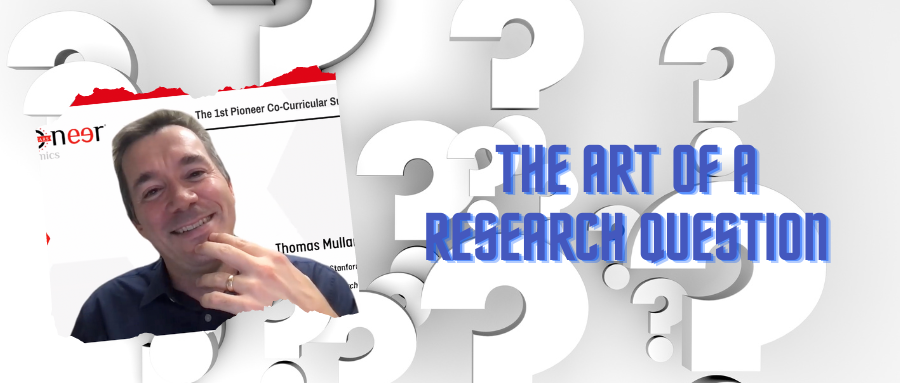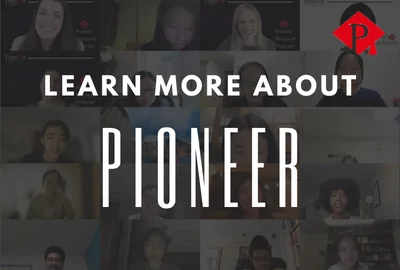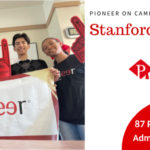An integral part of the research process is the phase that comes after the researcher has started, but before a researcher actually knows what it is they are researching.
This is the focus of Dr. Mulaney’s talk: teaching students how to navigate the uncertainty of what he considers a crucial moment in the cycle of inquiry.
Perhaps contrary to popular belief, this crucial moment is also an extremely common phase of the research process, and not just for high schoolers or beginner researchers. It’s a phase that comes in every single research project that an individual undertakes. It’s when you’ve set out on the research path, you’ve started looking at materials, you’ve started diving through primary sources, you may even have some really deep passions. And yet if someone were to really ask you what is it that you’re working on, the honest answer is…you don’t really know.
And as you can probably imagine, if you don’t really know yet what it is you’re working on, it’s awfully hard to build a bibliography and do a literature review, a review of the scholarship on your subject. It’s very difficult to talk about your work, to decide the parameters, the boundaries of it.
And so it’s a very challenging and dangerous period of time. Dangerous because this is when students are prone to get stuck and give up.
The book Dr. Mulaney wrote with sociologist Christopher Rea, Where Research Begins: Choosing a Research Project that Matters to You and the World, addresses this issue, one that is near and dear to his heart.
“I don’t want people to get lost here because there’s a true belief that every single student has the capacity to do not just impressive work to impress the instructor but truly new, critically important, sophisticated, brilliant work if we give them the basic tool to do so.”
Where Research Begins deals with this central question:
What do you do as a researcher before you know what you’re doing?
To frame his talk, Dr. Mulaney asked audience members to think of being a small child who’s trying to reach a cookie jar that is just out of reach. The cookie jar in this metaphor is the world of research. And the focus of his talk is the equivalent of when this little kid discovers that the way you get a cookie jar is by walking over to the living room, getting a dining room chair, pushing it across the floor to the counter, stepping up on the chair, and then suddenly the counter is open and available to them, and hence the cookie jar, too.
To begin, Dr. Mulaney posited:
What’s the difference between instruction and mentorship?
Instruction is the sense that I am in possession of a lot of information about a subject.
Mentorship is when you have a student that you are trying to help who, technically speaking, within a very short span of time in the course of their research, knows way more about the subject matter than you.
Drawing from this idea of mentorship, Dr. Mulaney then asked:
What does it look like to try to learn how to do research?
What does it look like to try to teach another person how to do research?
The argument that he put forward is that, as a teacher, what you’re really trying to do and what you are truly an expert in is how to navigate uncertainty.
So teachers need to ask themselves:
What is it that I know far better than my students do?
His answer:
What I am more trained in than my students are is how to confront the anxiety, uncertainty, and confusion that happens in the beginning stages of research. The time when I don’t even know what it is about. When I don’t know how to make heads or tails of it. When I don’t even understand the basics.
Teachers can model for students what it looks like when a more experienced researcher doesn’t know what the heck is going on. How they turn that chaos and that uncertainty into questions—not into answers—but into questions.
And then from these questions, we can start to build a research project that gets us to answers.
With mentorship, you’re helping someone go someplace you’ve never been, which is different in many ways from instruction.
Dr. Mulaney’s goal is to share some basic things that any student can use, and that any educator, instructor, and mentor can try out for themselves.
Now, where does all of this come from? A moment of pride. The tremendous pride Dr. Mulaney holds for his second book, The Chinese Typewriter: A History.
When he started researching the book, Dr. Mulaney described feeling a sense of “home” and this led him to pursue the project, despite it taking years for him to understand what it was that he cared about and concerns from colleagues and friends that he may be committing “career suicide” from the endeavor.
To explain this experience and the pride he derived from it, Dr. Mulaney spoke of an intrinsic certainty, of confidence, like the feeling of meeting a soulmate, the undoubted certainty that this is the one.
And he realized as he talked to other scholars, that they experienced that feeling, too.
High schoolers, college students, grad students experience it also as well as the opposite. Everyone experiences the feeling of sharing an idea with another person (a teacher, an advisor, a colleague, a granting commission) and having them heap accolades upon you. And yet deep down, you think, I guess I should do this. Everyone likes it. Everyone tells me I’m smart when I say this, but I don’t want to marry this project. But I don’t know how to say it. And now I’m confused. Who is right, who is me? What is the voice that I should listen to?
After years of experience as a researcher and teacher, Dr. Mulaney has honed in on this crucial moment, and now leverages it as what enables students to engage in what he finds the true process of educational transformation.
“I’m done holding off the most exciting part of what it is that I do, until my students reach a certain level of being advanced,” he said. “The second they walk in the door, I want them in the archives. The second they walk in the door, I want them to feel the terror and promise and excitement of the uncertainty of research, because that’s why I do it. And so why would I withhold that from them? That’s the fun part…And they’re ready for it. They need scaffolding, they need structure, but they are ready for it.”
Dr. Mulaney describes that the results have been like night and day: the level of quality of what his students are producing, the level of engagement that students bring to their work he describes as “shockingly good.”
So on to the techniques:
The act of record keeping in this stage of research is critical.
Record-keeping is self-evidence, a kind of forensic analysis of the chaos going on inside your head. Remember, you don’t know yet what it is you’re working on. Figuring out what it is you’re doing is actually part of the research process. You are studying yourself at the same time as you’re studying the material, especially in the first stage of a research process.
This saves time in the long run, understanding the problem that motivates the research.
Go small or go home.
Give up on trying to show how smart you are. Find mentors, colleagues, friends with whom you feel safe being inarticulate.
Generate questions from a primary source. Ask as many of them as possible—in a condensed amount of time—that have no aspiration whatsoever to meaning, to interpretation, to significance.
Some examples Dr. Mulaney shared from a midterm exam he gave with the instruction to ask as many meaningless questions as possible about a photograph include:
- Where was this photo taken?
- Why does the race travel through this specific location?
- What is that wall structure in the background?
- What are the nationalities of the people gathered?
- Who are the men in the foreground and what are they doing with those ropes?
- How long does it take to get from Paris to Peking?
- Why is there a race from Paris to Peking?
- Why does the race occur on unpaved roads?
- What kind of cars are in this race?
- Who took this photo?
- How many racers participated
- Were Chinese allowed to race?
- Why is a photo being taken of this particular location or moment?
- Who won the race?
- Are there spectators?
- Did people get lost?
The reason for asking as many meaningless questions as possible?
- Each of these questions gives you a clear sense of the researcher’s very next step. Any one of the questions on this list gives you a clear compass about where to go next.
- It gives you the chance to reflect back to the researcher, or to yourself, self-evidence of where the true interest lies. If you give the same photograph to 1000 different people, there’s going to be some questions that are common to all of them, but they’re going to be ones that are different. The primary source gets the student, the researcher, to the moment of realization, the moment of saying, “Yeah, I am really interested in XXX.”
What you want to cultivate to the extent that you as a researcher and also you as an educator who can mentor this for other researchers, is your ability to stand in front of any object and go boom…question, question, question, question, question, and on and on and on…the speed is not important. It’s the meaninglessness and not giving up after one question or two questions or five questions. This will give you evidence of yourself and what it is that you are concerned with. It’s going to give you clarity about the very next source you might want to find.
So ask meaningless questions. Don’t allow yourself, don’t allow your students, to jump to meaningful questions because they will always miss an opportunity.
Think outside the cereal box.
The moment you ask a question and the moment you get excited about it seems like the right time to immediately start answering that question. But what you want to spend a lot of time in the beginning of the research process doing is educating your question, not answering it, educating and refining it.
Many questions in the beginning of a project, have a kind of naivete to them a sort of silliness and immaturity to them. That’s not a bad thing. This is how it is for everyone.
Start with the question but don’t start answering it, because it’s not yet been refined.
And remember what a primary source is: a source is primary with respect to a question.
- Depending on your question, a source could be primary or secondary, and
- A source could be primary to researchers in fundamentally different ways.
To illustrate this with his students, Dr. Mulvaney puts a rapid, at-home COVID test in front of them and asks, how many projects can you imagine in which this is a primary source?
There could be 100 different honors thesis final projects in which this is a primary source and all of them would be very different from each other.
In sum, all of the exercises in Where Research Begins are designed to slow the researcher down, keep them in the starting phases of research, and encourage them to understand that work needs to be done to actually figure out what it is that they’re working on. Because the moment they figure that out, then they push the chair to the countertop, climb up, and eat all the cookies in the jar.
You can get all the support you need in the world, but we need to help ourselves and we need to help our students learn:
How do we push the chair to the counter in the first place?


 Doing research is commonplace.
Doing research is commonplace.


